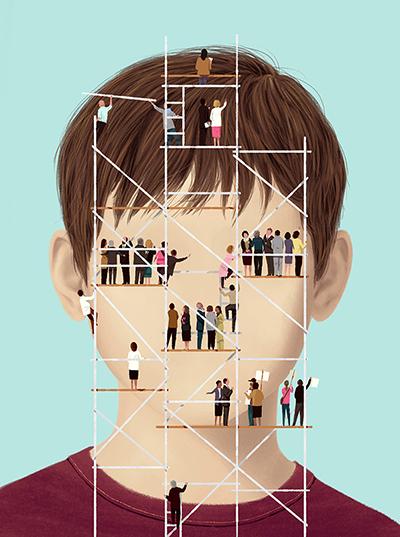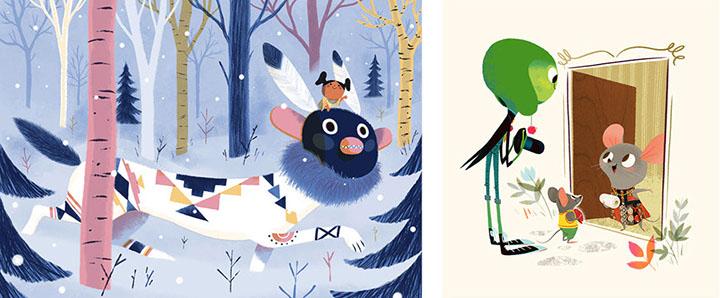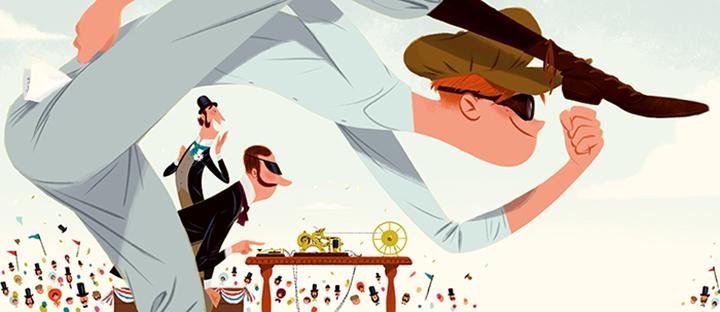Illustrator Profile - Leo Espinosa: "Curiousity has led my career"

|
|
|
MY LIFE:
I’m a Salt Lake City-based
graphic designer and illustrator, originally from Bogotá, Colombia. I’m married to Laura Espinosa, who’s also a designer, and we have two children, Benjamin and
Sofía.
My father was an architect and my mother a high school art teacher. I’m the second of three children. Our parents always encouraged any artistic endeavor and frequently asked us our opinion about their own work. I have clear memories of my dad leaving me in front of his blueprints, figuring out what would be the best way to lay out an apartment. He would come back after awhile and draw all my ideas as if they were any good. My parents never objected to their children overdosing on cartoons or staying up late drawing, keeping them company while they worked.
Sadly my dad passed away when I was 13, and things became very difficult at home. I chose to study graphic design, not only because I was inspired by record covers, rock band logos, and comics, but because I knew it would get me work quickly.
Even though my illustration career didn’t kick off until the mid-90s, I like to think that I started working while I was still attending design school. I got a small job doing storyboards for an ad agency, which lead to a designer position, and later on I became an art director; by the time I left Colombia at the age of 22, I had worked in three large multinational agencies.
But that whole beginning of my career felt rushed, and didn’t really happen because I wanted it. Design and illustration were relatively new in Colombia, and advertising was one of the few fields a graphic designer could earn a living in. So in 1992, looking for a bit of light and inspiration, I went to New York to attend Milton Glaser’s summer workshop at School of Visual Arts. What I didn’t know is that I was going to meet my future wife in the elevator of the school, both running late for our first session. We often joke that Glaser’s class changed our lives forever.
After a short period working at a small design studio in the Flatiron District, I got tired of giving away all the cool illustration assignments, so I quit my job, bought a page in a couple of source books and became a full time illustrator.
MY WORKSPACE:
We live in a small midcentury house at the edge of the
city, and my studio sits in one its corners, facing the backyard and the Wasatch Mountains. It’s a small space with large windows that allow me to spot every animal that wonders through our
trees; my favorite are the large families of California quails that always go by marching in line. I like stepping out to the patio to read my assignments and do my sketches. I love it here because
it’s quiet, and being close to nature clears my head, making the creative process more enjoyable.
HOW I MAKE MY ILLUSTRATIONS:
It’s incredibly simple. I do my
sketches in pencil on marker paper, then I either scan them or take a photo with my phone, so I can use it as a loose template when I do the final artwork in the computer. For more than 10 years I
used Adobe Illustrator as my main digital medium; I used to like the sharp lines, flat colors, and how practical it was when adding type or other design elements to my illustrations. But one day I
started craving textures and more organic shapes I could not achieve using Illustrator. So I bought a Wacom tablet and started painting in Photoshop, which has completely transformed, not only the way
I work, but the direction of my career. I pay a lot of attention to composition and color, which I tried to keep as limited as the tools I use; for each project, I choose only one or two digital
brushes from Alex Dukal or Kyle Webster.
MY FIRST BIG BREAK:
When I made the switch from art director to illustrator, I focused on editorial assignments and I was lucky to have work from the
very beginning. But the big break happened much later, when I started to get itchy for a different kind of project. In 2003 I got a chance to design a couple of watches for Swatch and that made me think of the immense array of applications my illustrations could have. I teamed up
with Laura, created Studio Espinosa, and we ventured into the licensing arena. During the period of four years, we created multiple intellectual properties, published our first children’s book,
Otis and Rae and the Grumbling Splunk, and partnering with American Greetings, we launched an animated TV series
called Sushi Pack, which aired on CBS for a couple of years. Our licensing gig was cut short by the collapse of the economy in 2008, but having tried something different was
incredibly fulfilling and exciting. We both learned a lot in the process.
MY INFLUENCES:
I should start with graphic designers that have the ability to draw, and
incorporate illustration seamlessly into their design. Paul Rand, Alvin
Lustig, Alexander Girard, Hervé Morvan, and Olle
Eksell have influenced me with their outstanding work, but in that same category I also have to mention Milton Glaser for
his design philosophy and Javier Mariscal, for allowing me to see the potential of illustration at the beginning of my career.
European comics have also been essential in the development of my work; they’ve been my best teachers of narrative, movement and composition. Yves Chaland sits at the top of my list, followed by Ever Meulen, Joost Swarte, Max, and Dupuy & Berberian.
Children book illustrators from the 50s and 60s like Aurelius Battaglia, the
Provensens, Abner Graboff, M.Sasek, and Mary Blair, for communicating so much with so little.
Movie
directors like Michel Gondry, Jacques Tati, and The Pink Panther (my favorite cartoon growing up), for their great lessons on storytelling.
Last but not least, anything related to the bicycle. I’ve been breathing, drawing and riding bikes since I was very young. I worship the bicycle as a design element and love its graphic culture.
MY MOST ADMIRED CREATIVE
PERSON:
David Bowie, for always being current and influential, even if he’s not around anymore.
MY CREATIVE INSPIRATION:
When
I’m in the studio, I look at my books. Currently I keep a couple on my desk: The Shape of Content by Ben Shahn and Thoughts on Design by Paul
Rand. I also like hiking with my dog or riding my bicycle up and down the canyons around my house to clear my head.
THE BIGGEST CHALLENGE OF WORKING
ALONE:
Finding balance between work and play. Because I love what I do, and I don’t follow a rigid schedule, I tend to work more than doing other things I like.
A
MEMORABLE ASSIGNMENT FROM THE PAST YEAR:
There were two. First, doing an internal project for a week, with the Art and Animation team of Facebook. This project came at a time when I
really needed some face-to-face collaboration, and being able to do it at their headquarters in Palo Alto exceeded my expectations. It definitely recharged my creative batteries.
The second one was working with my 17-year-old son, Ben, in a short animated clip for Masa, my favorite bakery back home in Colombia. Ben’s animation skills came in really handy in this project, and I was over the moon collaborating with him.
DREAM
ASSIGNMENT:
Designing a house.
MY FAVORITE ART DIRECTOR:
I love working with Shiu Pei Luu from Facebook, because of her collaborative
approach to art directing. Every project I do with her feels like a team achievement. Chris Curry from The New Yorker pushes me to be a better illustrator. My good
friend Lucho Correa makes me laugh and shares his clear understanding of design. And of course, it would be impossible not to
mention SooJin Buzelli. SooJin is also a dear friend, but when
it’s about work, she is all business. The results she gets from illustrators are a clear sign of her professionalism.
SOME OF MY FAVORITE ILLUSTRATORS:
They’re simply too many to
list. I like the ones that don’t try too hard to be unique, the ones that keep pushing their boundaries, that care more about growing as artists than they care about style. I like the ones who
like to tell stories. Here’s a few of them: Isidro Ferrer, Federico
Jordán, John Hersey, Carson Ellis, Keith Negley, Beatrice Alemagna, Roman Klonek, and Invisible Creature.
OTHER WORK:
I taught Design for Illustrators at RISD before moving to Utah, and if I
wouldn’t be so busy I would love to teach again. I do character design and a bit of art direction for animated spots for TV and web.
HOW I STAY CURRENT:
Before being an illustrator I was a full time designer and art director. As an illustrator I began with editorial work, but quickly moved into character
and product design, animation, logo design, comics, gallery work and lately children’s books, all combining illustration and design. Curiosity has led my career and it has proven to be a good
business strategy.
HOW I PROMOTE
MYSELF:
I promote myself very little. I try to enter at least one competition a year, but not necessarily in illustration. This year I submitted a project featuring type and illustration
I did for Facebook to Communication Arts’ Typography Annual and it got in. It’s a good way to broaden my client base. I’m active in social media, mainly Instagram, which works great
for self-promotion and inspiration at the same time.
ADVICE FOR SOMEONE STARTING OUT:
Doing good work is not enough. Remember that we are commercial artists. Don’t
forget the commercial part, or the art part won’t survive.
See more Leo Espinosa illustrations, new work and updates:
Website
Instagram: @studioespinosaworks
Facebook
Vimeo
Tumblr









